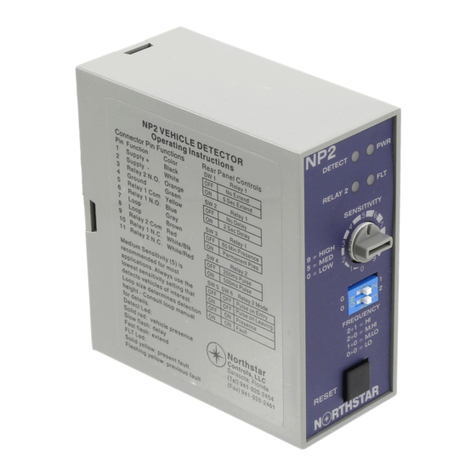
Description – NT11 and NT11-E
Northstar Controls LLC single channel NT11 and single channel with extend & delay timing
NT11-E quality products of the latest design to provide consistent response times, and superior
noise immunity for reliable operation.
The NT11 and NT11-E have four operating frequencies controlled by front panel DIP switches
to help eliminate crosstalk between loops connected to different detectors. Tuning is fast and
automatic with correct power applied or pressing the reset. With power applied the detector will
tune to the loop and continuously track and adjust to environmental drifts. Presence time is
consistent and substantially independent of vehicle type.
Front panel indicators (LED’s) include Detect (DET) which is Red solid during current detect
and flashing to indicate extension or delay operation. Additionally the DET indicator will flash
with a particular sequence when the detector is in the fault condition. The Fault (FLT) will be
solid yellow to indicate a current fault and will flash a sequence to indicate a previous fault
condition. The fault type sequence is one flash and one space is for an open, two flashes and one
space is for a short and three flashes and a space indicate a greater than 25% inductance change.
The NT11 and NT11-E are fail-safe detectors so in fault they will provide a constant output until
the fault is cleared.
Characteristics – NT11 and NT11-E
• Operating mode: Presence = 15 minutes (Short), 120 minutes (Long), Pulse = 125ms +/-
25ms.
• Pulse paralysis: When used in pulse mode, a pulse paralysis time of two seconds is
incorporated to prevent multiple pulses being produced when a vehicle remains over the
loop for an extended period.
• Sensitivity: 16 levels of sensitivity are available, selected by front panel DIP switches.
Medium sensitivity is used for most applications, this is a setting of seven or eight.
Always use the lowest sensitivity setting that detects the desired vehicles.
• Frequency: Four separate frequency setting are controlled by front panel DIP switches.
Frequency range is 15 to 150 KHz. Always reset the detector after changing settings.
• Timing options (E model only): Output signal may be extended from 0 to 15.75 seconds
in .25 second increments and delayed from 0 to 63 seconds in 1 second increments. Both
functions are activated by front panel DIP switches. *Delay timing function may be
inhibited by a 120VAC signal (reference Neutral) applied to Pin J of the connector.
• Reset: Channel may be reset by pressing the reset button or by temporarily selecting
another sensitivity or mode setting then returning to the desired value.
Page 2




























